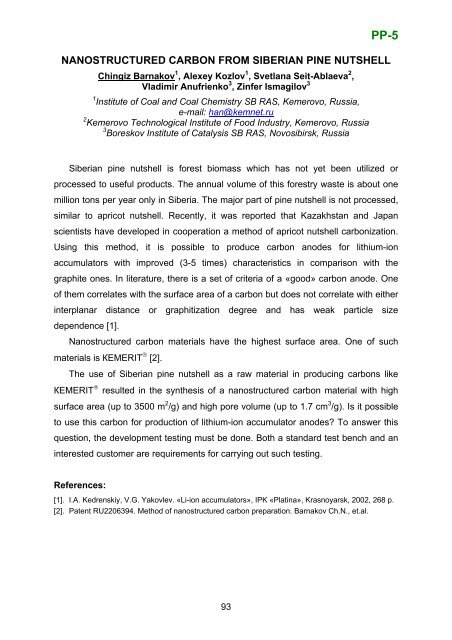Boreskov Institute of Catalysis SB RAS, Novosibirsk, Russia
Boreskov Institute of Catalysis SB RAS, Novosibirsk, Russia
Boreskov Institute of Catalysis SB RAS, Novosibirsk, Russia
- No tags were found...
You also want an ePaper? Increase the reach of your titles
YUMPU automatically turns print PDFs into web optimized ePapers that Google loves.
PP-5NANOSTRUCTURED CARBON FROM SIBERIAN PINE NUTSHELLChingiz Barnakov 1 , Alexey Kozlov 1 , Svetlana Seit-Ablaeva 2 ,Vladimir Anufrienko 3 , Zinfer Ismagilov 31 <strong>Institute</strong> <strong>of</strong> Coal and Coal Chemistry <strong>SB</strong> <strong>RAS</strong>, Kemerovo, <strong>Russia</strong>,e-mail: han@kemnet.ru2 Kemerovo Technological <strong>Institute</strong> <strong>of</strong> Food Industry, Kemerovo, <strong>Russia</strong>3 <strong>Boreskov</strong> <strong>Institute</strong> <strong>of</strong> <strong>Catalysis</strong> <strong>SB</strong> <strong>RAS</strong>, <strong>Novosibirsk</strong>, <strong>Russia</strong>Siberian pine nutshell is forest biomass which has not yet been utilized orprocessed to useful products. The annual volume <strong>of</strong> this forestry waste is about onemillion tons per year only in Siberia. The major part <strong>of</strong> pine nutshell is not processed,similar to apricot nutshell. Recently, it was reported that Kazakhstan and Japanscientists have developed in cooperation a method <strong>of</strong> apricot nutshell carbonization.Using this method, it is possible to produce carbon anodes for lithium-ionaccumulators with improved (3-5 times) characteristics in comparison with thegraphite ones. In literature, there is a set <strong>of</strong> criteria <strong>of</strong> a «good» carbon anode. One<strong>of</strong> them correlates with the surface area <strong>of</strong> a carbon but does not correlate with eitherinterplanar distance or graphitization degree and has weak particle sizedependence [1].Nanostructured carbon materials have the highest surface area. One <strong>of</strong> suchmaterials is КEMERIT ® [2].The use <strong>of</strong> Siberian pine nutshell as a raw material in producing carbons likeКEMERIT ® resulted in the synthesis <strong>of</strong> a nanostructured carbon material with highsurface area (up to 3500 m 2 /g) and high pore volume (up to 1.7 cm 3 /g). Is it possibleto use this carbon for production <strong>of</strong> lithium-ion accumulator anodes? To answer thisquestion, the development testing must be done. Both a standard test bench and aninterested customer are requirements for carrying out such testing.References:[1]. I.A. Kedrenskiy, V.G. Yakovlev. «Li-ion accumulators», IPK «Platina», Krasnoyarsk, 2002, 268 p.[2]. Patent RU2206394. Method <strong>of</strong> nanostructured carbon preparation. Barnakov Ch.N., et.al.93
















